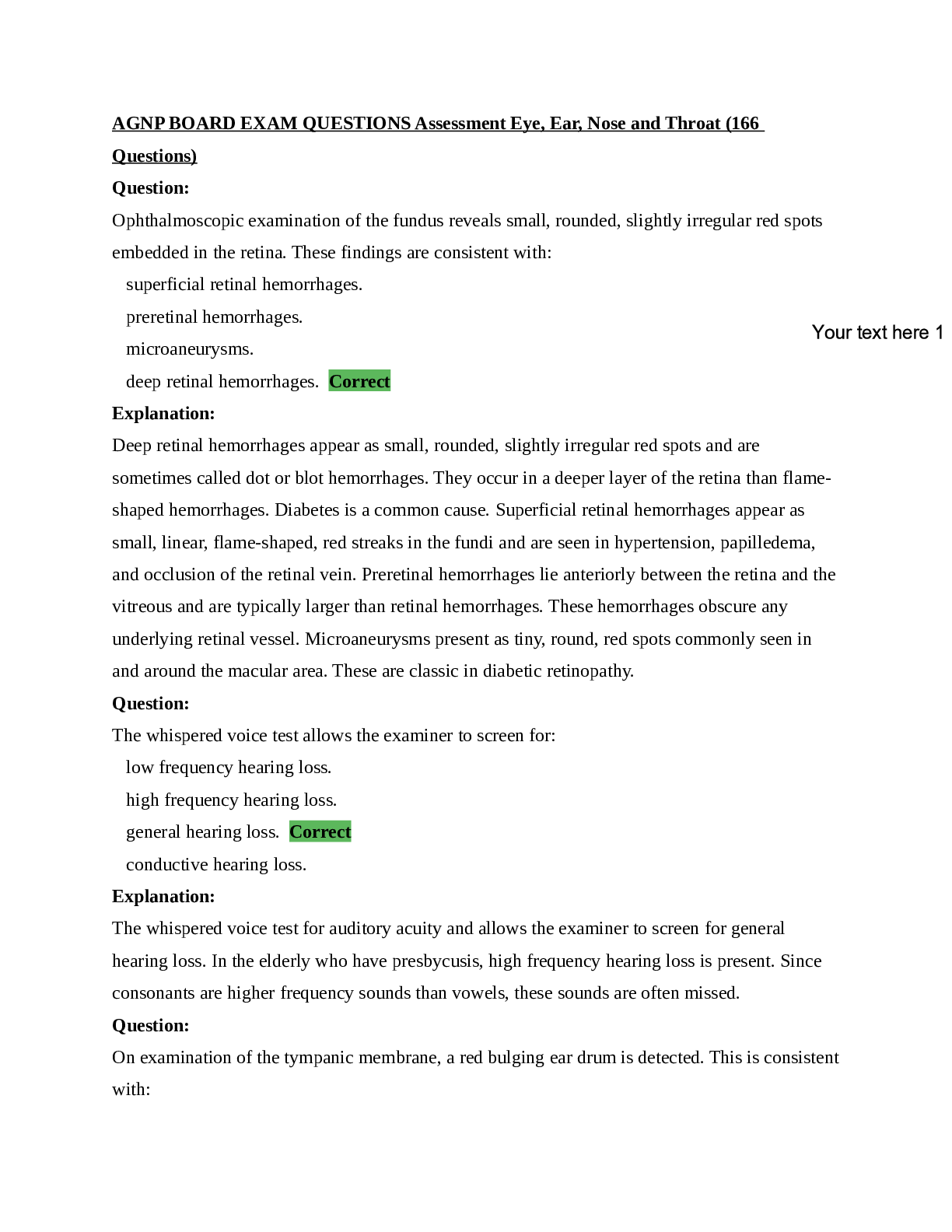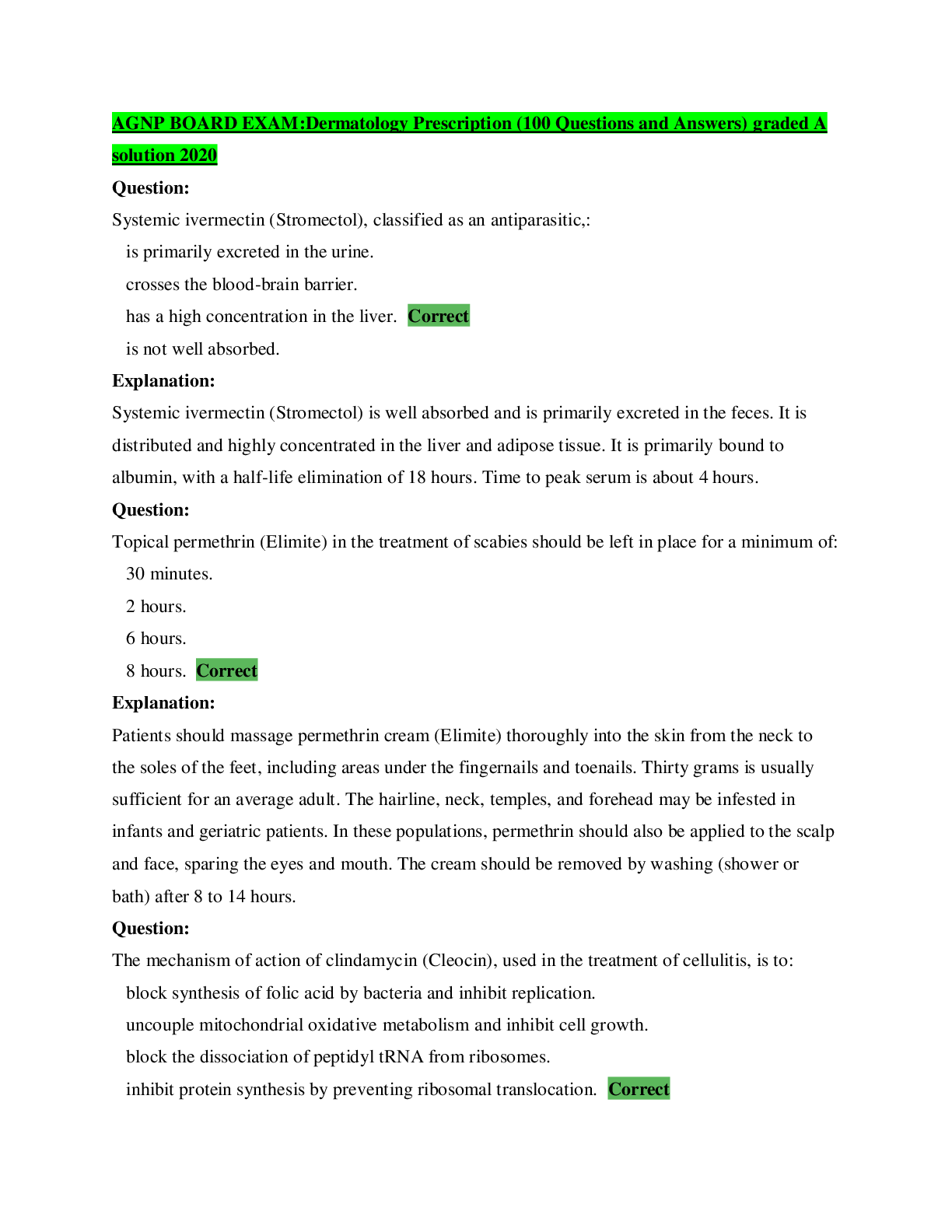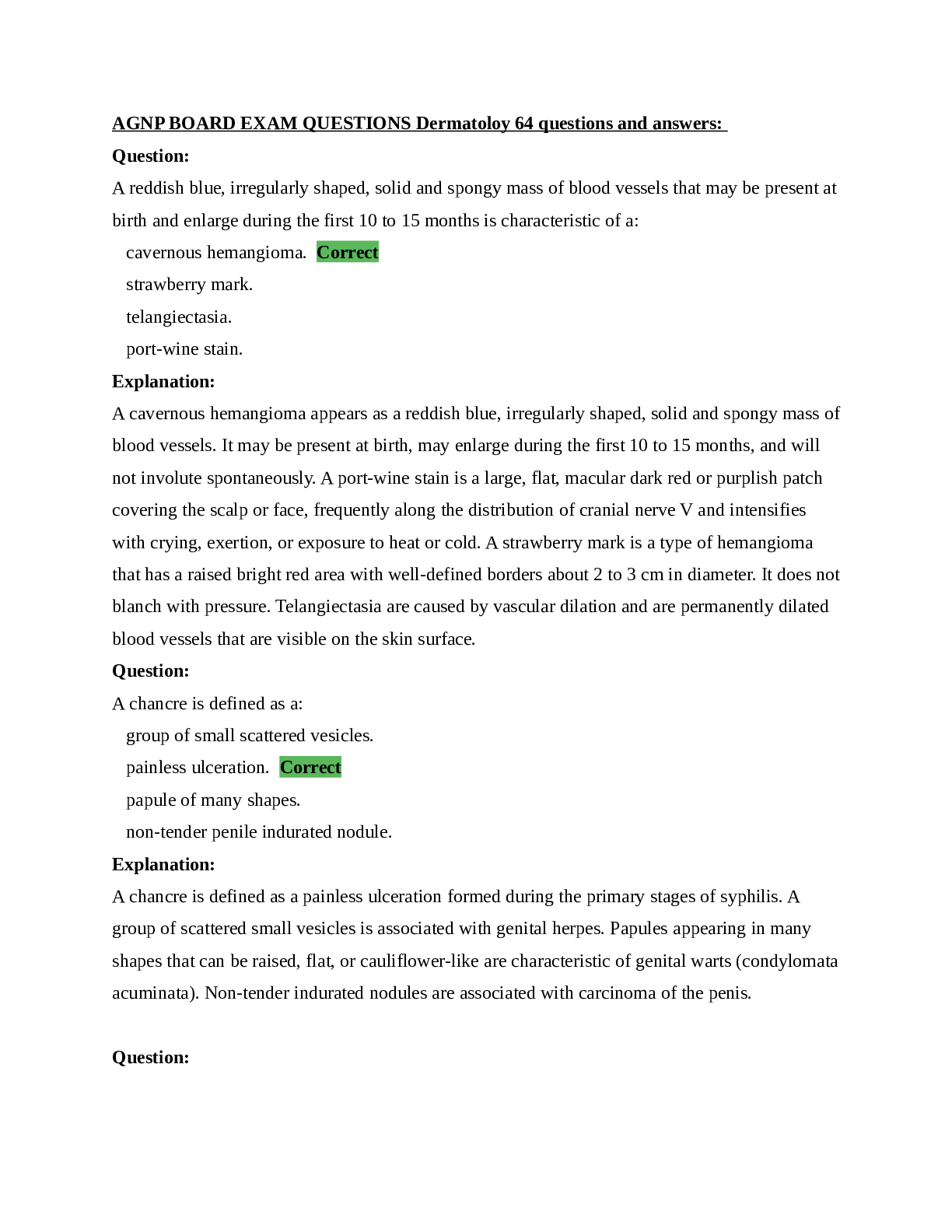*NURSING > QUESTIONS & ANSWERS > South University, Savannah NSG 6320 AGNP BOARD EXAM QUESTIONS Women's Health Assessment Already Pass (All)
South University, Savannah NSG 6320 AGNP BOARD EXAM QUESTIONS Women's Health Assessment Already Passed
Document Content and Description Below
AGNP BOARD EXAM QUESTIONS Womens Health Assessment (70 Questions) Question: A woman complains of infrequent menses with intervals greater than 35 days. This condition is termed: oligomenorrhea. Co... rrect polymenorrhea. metrorrhagia. menorrhagia. Explanation: Oligomenorrhea is infrequent bleeding with menses occurring at greater than 35- day intervals, or 4-9 menstrual cycles per year. Polymenorrhea occurs when there are fewer than 21-day intervals between menses. Menorrhagia refers to excessive or prolonged menstrual flow occurring at regular intervals. Metrorrhagia refers to intermenstrual bleeding. Question: Upon examination of the vagina, a swollen red ring is noted around the urethral opening. This finding is most consistent with a: prolapse of the urethral mucosa. Correct urethral caruncle. cystocele. cystourethrocele. Explanation: A prolapsed urethral mucosa forms a swollen red ring around the urethral meatus. A urethral caruncle is a small, red, benign tumor visible at the posterior part of the urethral meatus. It usually occurs in postmenopausal women. A cystocele is a bulge of the upper two-thirds of the anterior vaginal wall and the bladder above it. It results from weakened supporting tissues. When the entire anterior vaginal wall, together with the bladder and urethra, is involved in the bulge, a cystourethrocele is present. Question: When palpating the cervix during the bimanual exam, cervical motion tenderness (chandelier sign) is noted. This tenderness could be suggestive of: retroversion of the uterus. pelvic inflammatory disease. Correct vulvar lesions. Bartholin gland infection. Explanation: Cervical motion tenderness, also known as Chandelier's sign, and/or adnexal tenderness, suggest pelvic inflammatory disease, ectopic pregnancy, or appendicitis. Question: When performing a rectal exam on a female, a hard nodular rectal "shelf" is palpable at the tip of the examiner's finger. This finding is suggestive of: an ovarian cyst. metastatic tissue in the rectouterine pouch. Correct rectal polyp. carcinoma of the rectum. Explanation: Widespread peritoneal metastases from any source may develop in the area of the peritoneal reflection anterior to the rectum. A firm to hard nodular rectal “shelf” may be just palpable with the tip of the examining finger. In a woman, this shelf of metastatic tissue develops in the rectouterine pouch, behind the cervix and the uterus. Rectal polyps and carcinoma of the rectum, if palpable, are typically located in the lower section of the rectum. To palpate the ovaries, a bimanual pelvic examination would be more appropriate. Question: When performing an examination of the external genitalia of a female patient, a small, firm, round cystic nodule in the labia is identified. This lesion is most consistent with: a syphilitic chancre. an epidermoid cyst. Correct Condylomata acuminata. genital herpes. Explanation: A small, firm, round cystic nodule in the labia suggests an epidermoid cyst. They appear yellowish in color with a dark punctum marking the blocked opening of the gland. A syphilitic chancre appears as a firm, painless ulcer and suggests the chancre of primary syphilis. Because most chancres in women develop internally, they often go undetected. Genital warts or Condylomata acuminata are warty lesions on the labia and within the vestibule resulting from infection with human papillomavirus. Genital herpes appears as shallow, small, painful ulcers on red bases. Question: In a female diagnosed with a first-degree uterine prolapse, the cervix: is located in its normal position. has slipped but is well within the vagina. Correct is located in the introitus. and vagina are outside the introitus. Explanation: Uterine prolapse occurs in progressive stages. The uterus becomes retroverted and descends down the vaginal canal to the exterior. In first-degree prolapse, the cervix is still well within the vagina. In second-degree prolapse, it is at the introitus. In thirddegree prolapse (procidentia), the cervix and vagina are outside the introitus. Question: When performing a bimanual exam of the vagina, the examiner should lubricate the index and middle fingers of a gloved hand. From a standing position, the fingers should be inserted into the vagina while exerting pressure primarily: anteriorly. posteriorly. Correct toward the "4-o"clock" position. toward the "8-o"clock" position. Explanation: When performing a bimanual exam of the vagina, the examiner should lubricate the index and middle fingers of one of the gloved hands, and from a standing position, insert them into the vagina while exerting pressure primarily posteriorly. Question: Chronic pelvic pain may be secondary to all of the above except: sexually transmitted diseases. sexual abuse. fibroids. peptic ulcer disease. Correct Explanation: Chronic pelvic pain (CPP) refers to pain of at least 6 months duration that occurs below the umbilicus. While gynecologic etiologies are common, CPP may be secondary to conditions in the urinary tract, GI tract, musculoskeletal system, and in the setting of mental health issues. Peptic ulcer disease affects the upper GI tract and produces symptoms above the umbilicus. Question: To palpate the uterus during a bimanual exam, the examiner would lubricate the index and middle fingers of one hand and insert them into the vagina. The other hand would be placed on the abdomen: near the symphysis pubis while pressing downward and elevating the cervix and uterus with the other hand. about midway between the umbilicus and symphysis pubis while elevating the cervix and uterus with the other hand. Correct just above the umbilicus while pressing downward and elevating the cervix and uterus with the other hand. just below the umbilicus while pressing downward and elevating the cervix and uterus with the other hand. Explanation: To palpate the uterus during a bimanual exam, the examiner would lubricate the index and middle fingers of one hand and insert them into the vagina. The other hand would be placed on the abdomen about midway between the umbilicus and the symphysis pubis. While elevating the cervix and uterus with the pelvic hand, press the abdominal hand in and down, trying to grasp the uterus between the two hands. Question: Examination of a female patient's right breast reveals a retraction of the nipple and areola. This finding is consistent with: breast cancer. Correct mastitis. Paget's disease of the breast. fibrocystic breast disease. Explanation: Retraction of the nipple and areola are suggestive of an underlying tumor. Mastitis is an inflammation of the breast tissue. Paget's disease is an uncommon form of breast cancer that starts with a scaly, eczema-like lesion that may weep, crust, or erode. Fibrocystic breast disease findings include lumps, thickening and swelling in the breast tissue, and becomes prominent immediately before onset of menses. Question: When performing the bimanual vaginal exam, uterine enlargement is noted. This enlargement could suggest: a malignancy. Correct retroversion of the uterus. retroflexion of the uterus. pelvic inflammatory disease. Explanation: Uterine enlargement may suggest pregnancy, uterine myomas (fibroids), or malignancy. Retroversion or retroflexion of the uterus, and pelvic inflammatory disease are not typical findings with enlargement of the uterus. Question: Upon examination of the vagina, a small, red, benign tumor is noted at the posterior part of the urethral meatus. This finding is most consistent with a: prolapse of the urethral mucosa. urethral caruncle. Correct cystocele. cystourethrocele. Explanation: A urethral caruncle is a small, red, benign tumor visible at the posterior part of the urethral meatus. A cystocele is a bulge of the upper two-thirds of the anterior vaginal wall and the bladder above it. It results from weakened supporting tissues. A prolapsed urethral mucosa forms a swollen red ring around the urethral meatus. When the entire anterior vaginal wall, together with the bladder and urethra, is involved in the bulge, a cystourethrocele is present. Question: Upon examination of the cervix, a yellow drainage is visible around the cervical os. This finding is most likely suggestive of: candidal vaginitis. cervical polyp. carcinoma of the cervix. mucopurulent cervicitis. Correct Explanation: Mucopurulent cervicitis produces purulent, yellow drainage from the cervical os, usually from Chlamydia trachomatis, Neisseria gonorrhoeae, or herpes infection. Candidal vaginitis produces a white and curd-like, thin discharge from the vagina and does not originate from the cervix. Typically a cervical polyp does not produce a cervical discharge. Carcinoma of the cervix begins in an area of metaplasia and usually does not produce a mucopurulent cervical discharge. Question: A woman complains of abnormally heavy and prolonged menstrual periods that occur at regular intervals. This condition is most likely: oligomenorrhea. polymenorrhea. metrorrhagia. menorrhagia. Correct Explanation: Menorrhagia refers to excessive or prolonged menstrual flow occurring at regular intervals. Polymenorrhea occurs when there are fewer than 21-day intervals between menses. Oligomenorrhea is infrequent bleeding with menses occurring greater than 35- day intervals, or 4-9 menstrual cycles per year. Metrorrhagia refers to intermenstrual bleeding. Question: If urethritis or inflammation of the paraurethral glands is suspected in a female patient, the index finger should be inserted into the vagina and: milk the urethra gently from the outside inward. milk the urethra gently from the inside outward. Correct massage the urethral meatus with the other hand. massage the pelvic floor muscles in a clockwise fashion. Explanation: If urethritis or inflammation of the paraurethral glands is suspected, the examiner should insert the index finger into the vagina and milk the urethra gently from inside outward. Note any discharge from or about the urethral meatus. If present, it should be cultured. Question: Pelvic floor muscle weakness may be due to all of the following except: aging. dyspareunia. Correct stress incontinence. Parkinson's disease Explanation: Pelvic floor muscle weakness from aging, vaginal deliveries, and neurologic conditions may be associated with stress incontinence. Question: The most common type of hernia in women is the: femoral hernia. indirect inguinal hernia. Correct incisional hernia. umbilical hernia. Explanation: An indirect inguinal hernia is the most common hernia in women. A femoral hernia is next in frequency. Question: In a female diagnosed with a second-degree uterine prolapse, the cervix: is located in its normal position. has slipped but is well within the vagina. is located in the introitus. Correct and vagina are outside the introitus. Explanation: Uterine prolapse occurs in progressive stages. The uterus becomes retroverted and descends down the vaginal canal to the exterior. In first-degree prolapse, the cervix is still well within the vagina. In second-degree prolapse, it is at the introitus. In thirddegree prolapse (procidentia), the cervix and vagina are outside the introitus. Question: Upon examination of the vagina, the entire anterior vaginal wall, together with the bladder and urethra create a bulge. This condition is most consistent with a: prolapse of the urethral mucosa. urethral caruncle. cystocele. cystourethrocele. Correct Explanation: When the entire anterior vaginal [Show More]
Last updated: 1 year ago
Preview 1 out of 21 pages
Instant download

Buy this document to get the full access instantly
Instant Download Access after purchase
Add to cartInstant download
Reviews( 0 )
Document information
Connected school, study & course
About the document
Uploaded On
Apr 22, 2022
Number of pages
21
Written in
Additional information
This document has been written for:
Uploaded
Apr 22, 2022
Downloads
0
Views
62

.png)
.png)
.png)
.png)
.png)
.png)
.png)
.png)
.png)
.png)
.png)












